

Compact Muon Solenoid
LHC, CERN
| CMS-PAS-BPH-15-008 | ||
| Measurement of the P1 and P′5 angular parameters of the decay B0→K∗0μ+μ− in proton-proton collisions at √s= 8 TeV | ||
| CMS Collaboration | ||
| March 2017 | ||
| Abstract: The angular distributions of the decay B0→K∗0μ+μ− are studied using data corresponding to an integrated luminosity of 20.5 fb−1 collected with the CMS detector at the LHC in proton-proton collisions at √s= 8 TeV. An angular analysis gives access to many physical observables, including P′5, which is of particular interest due to measurements from the LHCb Collaboration, that exibit potential discrepancy with the standard model. Based on a sample of 1397 signal events, the P1 and P′5 angular parameters are determined as a function of the dimuon invariant mass squared. The measurement are in agreement with standard model predictions. | ||
|
Links:
CDS record (PDF) ;
inSPIRE record ;
CADI line (restricted) ;
These preliminary results are superseded in this paper, PLB 781 (2018) 517. The superseded preliminary plots can be found here. |
||
| Figures & Tables | Summary | Additional Figures | References | CMS Publications |
|---|
| Figures | |
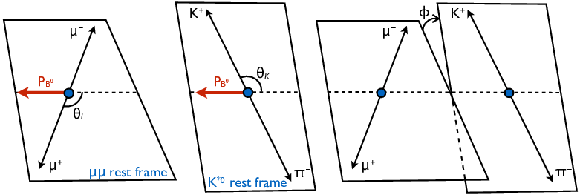
png pdf |
Figure 1:
Sketch showing the definition of the angular variables θl (left), θK (middle), and ϕ (right) for the decay B0→K∗0(K+π−)μ+μ−. |
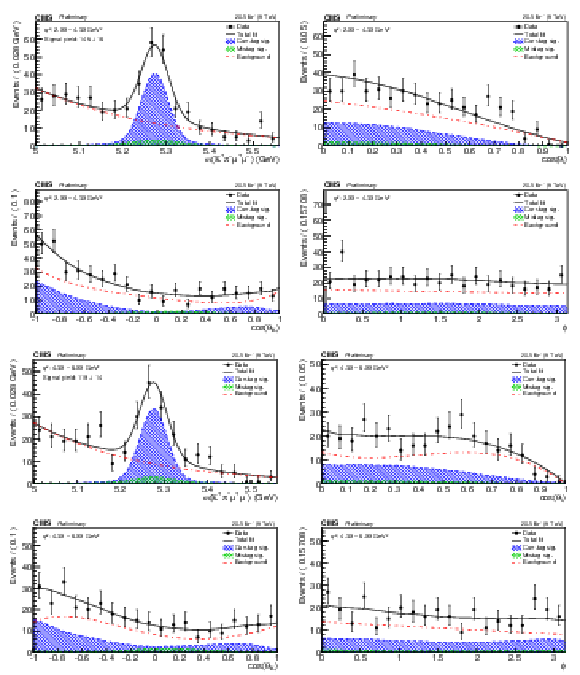
png pdf |
Figure 2:
K+π−μ+μ− invariant mass and angular distributions for the second and third q2 bin (top four plots) 2.00 <q2< 4.30 GeV2, and (bottom four plots) 4.30 <q2< 6.00 GeV2. Overlaid on each plot is the projection of the results for the total fit, as well as for the three components: correctly tagged signal, mistagged signal, and background. The vertical bars indicate the statistical uncertainties. |
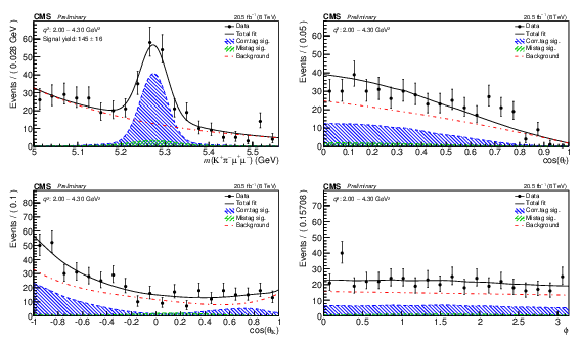
png pdf |
Figure 2-a:
K+π−μ+μ− invariant mass and angular distributions for the second q2 bin, 2.00 <q2< 4.30 GeV2. Overlaid on each plot is the projection of the results for the total fit, as well as for the three components: correctly tagged signal, mistagged signal, and background. The vertical bars indicate the statistical uncertainties. |
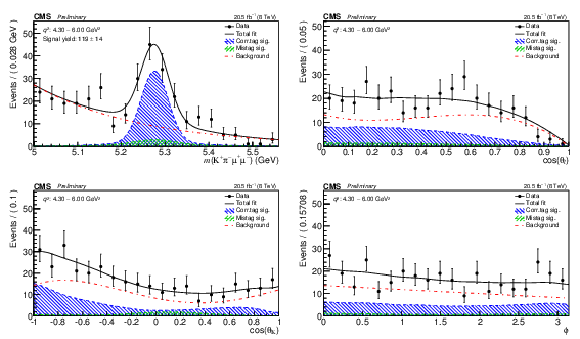
png pdf |
Figure 2-b:
K+π−μ+μ− invariant mass and angular distributions for the third q2 bin, 4.30 <q2< 6.00 GeV2. Overlaid on each plot is the projection of the results for the total fit, as well as for the three components: correctly tagged signal, mistagged signal, and background. The vertical bars indicate the statistical uncertainties. |
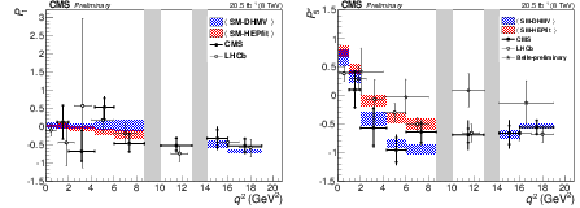
png pdf |
Figure 3:
Measured values of P1 and P′5 versus q2 for B0→K∗0μ+μ− from CMS, compared with LHCb [30] and Belle [32] results. The statistical uncertainty is shown by the inner vertical bars, while the outer vertical bars give the total uncertainty. The horizontal bars show the bin widths. The vertical shaded regions correspond to the J/ψ and ψ′ resonances. The red and blue hatched regions show two SM predictions averaging over each q2 bin to provide a direct comparison to the data. The SM-DHMV result is derived from Refs. [17,24], while SM-HEPfit result from Refs. [48,49]. Reliable theoretical predictions are not available near the J/ψ and ψ′ resonances. |
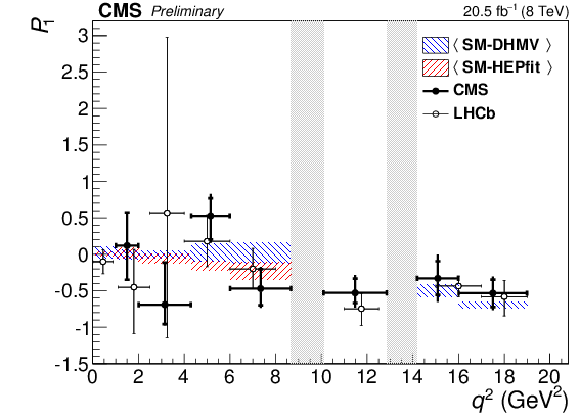
png pdf |
Figure 3-a:
Measured values of P1 versus q2 for B0→K∗0μ+μ− from CMS, compared with LHCb [30] and Belle [32] results. The statistical uncertainty is shown by the inner vertical bars, while the outer vertical bars give the total uncertainty. The horizontal bars show the bin widths. The vertical shaded regions correspond to the J/ψ and ψ′ resonances. The red and blue hatched regions show two SM predictions averaging over each q2 bin to provide a direct comparison to the data. The SM-DHMV result is derived from Refs. [17,24], while SM-HEPfit result from Refs. [48,49]. Reliable theoretical predictions are not available near the J/ψ and ψ′ resonances. |
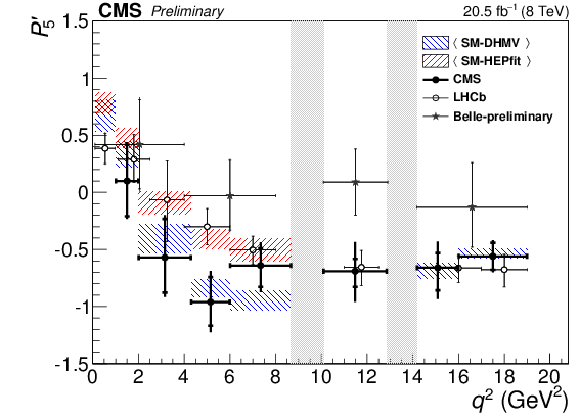
png pdf |
Figure 3-b:
Measured values of P′5 versus q2 for B0→K∗0μ+μ− from CMS, compared with LHCb [30] and Belle [32] results. The statistical uncertainty is shown by the inner vertical bars, while the outer vertical bars give the total uncertainty. The horizontal bars show the bin widths. The vertical shaded regions correspond to the J/ψ and ψ′ resonances. The red and blue hatched regions show two SM predictions averaging over each q2 bin to provide a direct comparison to the data. The SM-DHMV result is derived from Refs. [17,24], while SM-HEPfit result from Refs. [48,49]. Reliable theoretical predictions are not available near the J/ψ and ψ′ resonances. |
| Tables | |
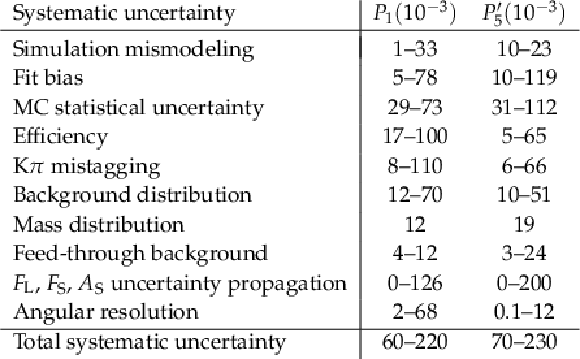
png pdf |
Table 1:
Systematic uncertainty contributions for the measurements of P1 and P′5. The total uncertainty in each q2 bin is obtained by adding each contribution in quadrature. For each item, the range indicates the variation of the uncertainty in the q2 bins. |
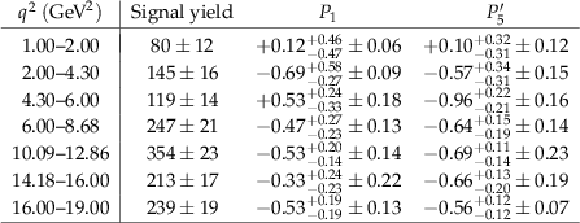
png pdf |
Table 2:
The measured signal yields, which include both correctly tagged and mistagged events, and the P1 and P′5 values, in bins of q2, for the decay B0→K∗0μ+μ−. The first uncertainty is statistical and the second is systematic. The bin ranges are selected to allow comparisons to previous measurements. |
| Summary |
| Using pp collision data recorded at √s= 8 TeV with the CMS detector at the LHC, corresponding to an integrated luminosity of 20.5 fb−1, an angular analysis has been performed for the decay B0→K∗0μ+μ−. In total, 1397 signal events are obtained. For each bin of the dimuon invariant mass squared (q2), unbinned maximum-likelihood fits were performed to the distributions of the K+π−μ+μ− invariant mass and the three decay angles, to obtain values of the P1 and P′5 parameters. The results are among the most precise to date and are consistent with standard model predictions and previous measurements. |
| Additional Figures | |
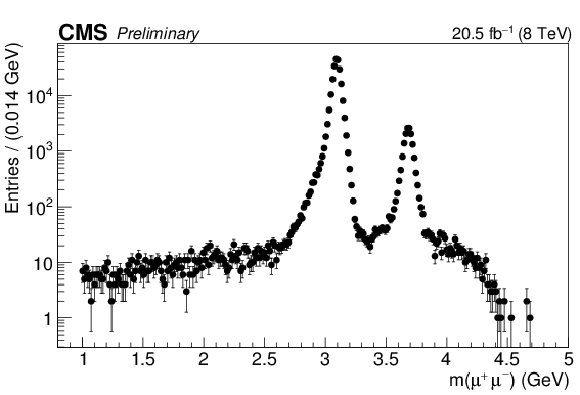
png pdf |
Additional Figure 1:
Spectrum of the di-muon invariant mass. The two peaks correspond to the J/ψ and ψ′ resonances used as control samples. |
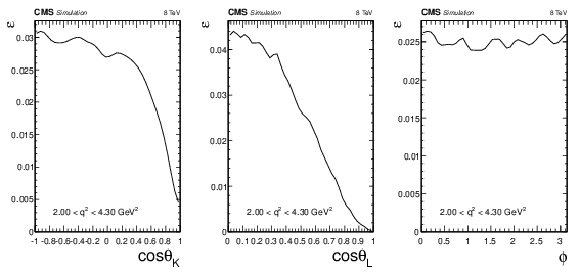
png pdf |
Additional Figure 2:
Projection of the efficiency computed on simulated events along the three angular variables cosθK, |cosθL|, ϕ for the second bin 2.00 <q2< 4.30 GeV2 for correctly tagged events. |
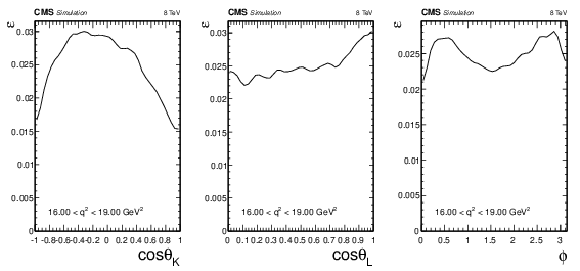
png pdf |
Additional Figure 3:
Projection of the efficiency computed on simulated events along the three angular variables cosθK, |cosθL|, ϕ for the seventh bin 16.00 <q2< 19.00 GeV2 for correctly tagged events. |
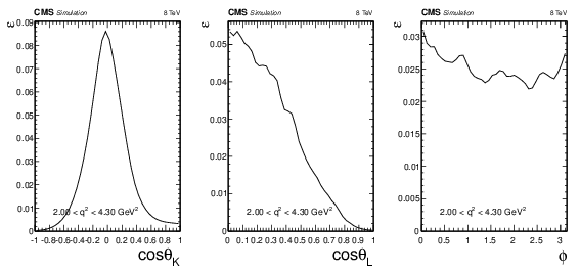
png pdf |
Additional Figure 4:
Projection of the efficiency computed on simulated events along the three angular variables cosθK, |cosθL|, ϕ for the second bin 2.00 <q2< 4.30 GeV2 for wrongly tagged events. |
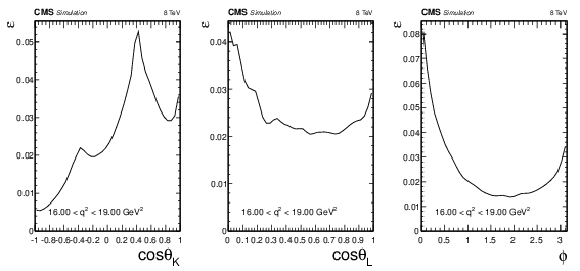
png pdf |
Additional Figure 5:
Projection of the efficiency computed on simulated events along the three angular variables cosθK, |cosθL|, ϕ for the seventh bin 16.00 <q2< 19.00 GeV2 for wrongly tagged events. |
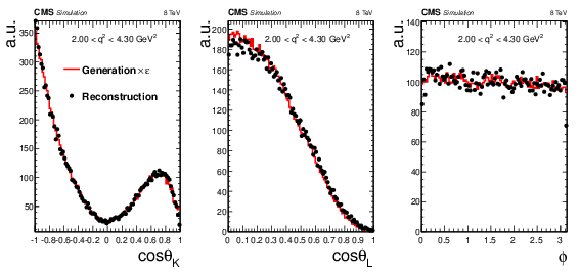
png pdf |
Additional Figure 6:
Closure test of efficiency using simulated events for correctly tagged events. Half of the simulated events are used to compute the efficiency, and the other half is used for the test. The black dots are are the simulated events reconstructed, the red histograms are the distribution of the events at generator level, multiplied by the efficiency. |
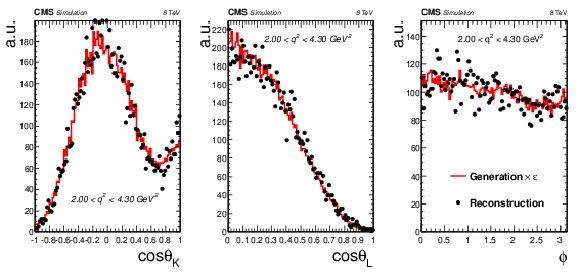
png pdf |
Additional Figure 7:
Closure test of efficiency using simulated events for wrongly tagged events. Half of the simulated events are used to compute the efficiency, and the other half is used for the test. The black dots are are the simulated events reconstructed, the red histograms are the distribution of the events at generator level, multiplied by the efficiency. |
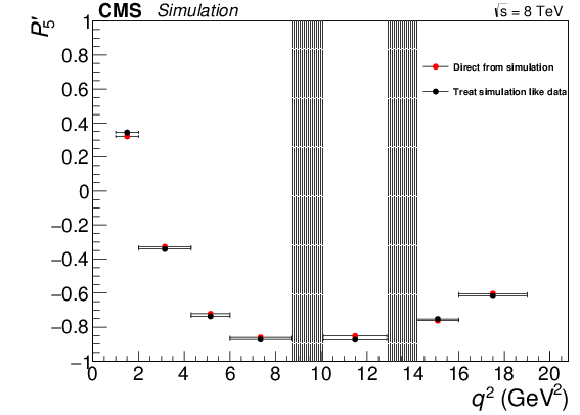
png pdf |
Additional Figure 8:
Closure test of the fitting results of P′5 for each q2 bin on simulated data. The results of the fit on reconstructed events (black dots) are compared with the fit on the generated events (red dots). The vertical shaded regions correspond to the J/ψ and ψ′ resonances. |
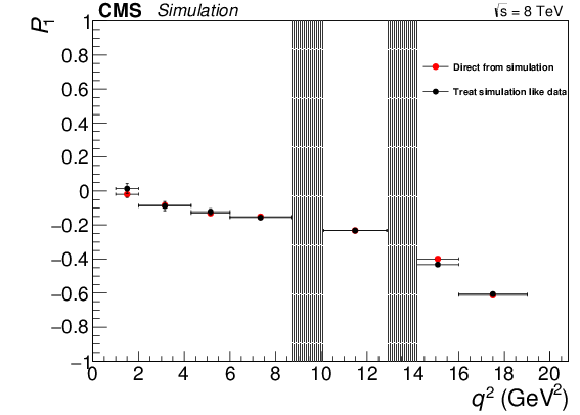
png pdf |
Additional Figure 9:
Closure test of the fitting results of P1 for each q2 bin on simulated data. The results of the fit on reconstructed events (black dots) are compared with the fit on the generated events (red dots). The vertical shaded regions correspond to the J/ψ and ψ′ resonances. |
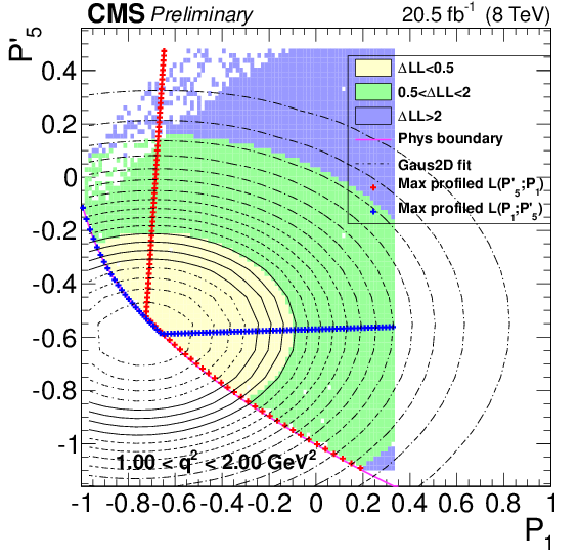
png pdf |
Additional Figure 10:
Distribution of L computed on data for third bin 2.00 <q2< 4.30 GeV2, in the P1,P′5 plane. The colored regions correspond to ΔlogL< 0.5 (yellow), 0.5 <ΔlogL< 2.0 (green), ΔlogL> 2.0 (purple), respectively. The magenta line represents the physical boundary, the physically allowed region being above that line. Superimposed is a bivariate Gaussian fit (dot-dashed line), and the position of the maxima of the profiled L along P1, with P′5 fixed, (blue crosses) and along P′5, with P1 fixed, (red crosses). |
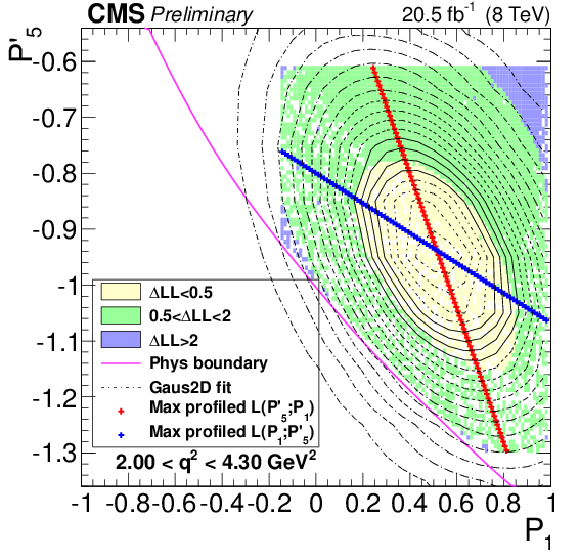
png pdf |
Additional Figure 11:
Distribution of L computed on data for third bin 4.30<q2<6.00 GeV2, in the P1,P′5 plane. The colored regions correspond to ΔlogL< 0.5 (yellow), 0.5 <ΔlogL< 2.0 (green), ΔlogL> 2.0 (purple), respectively. The magenta line represents the physical boundary, the physically allowed region being above that line. Superimposed is a bivariate Gaussian fit (dot-dashed line), and the position of the maxima of the profiled L along P1, with P′5 fixed, (blue crosses) and along P′5, with P1 fixed, (red crosses). |
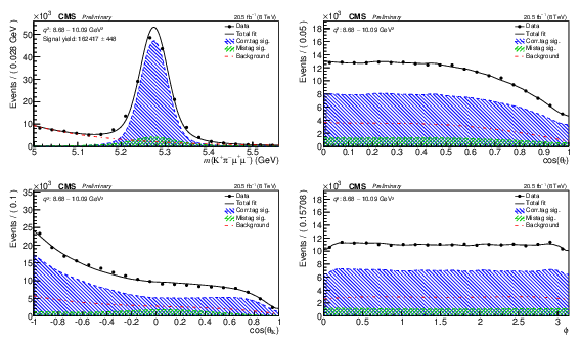
png pdf |
Additional Figure 12:
K+π−μ+μ− invariant mass and angular distributions of the control channel J/ψ on data. Overlaid on each plot is the projection of the results for the total fit, as well as for the three components: correctly tagged signal, mistagged signal, and background. The vertical bars indicate the statistical uncertainties. |
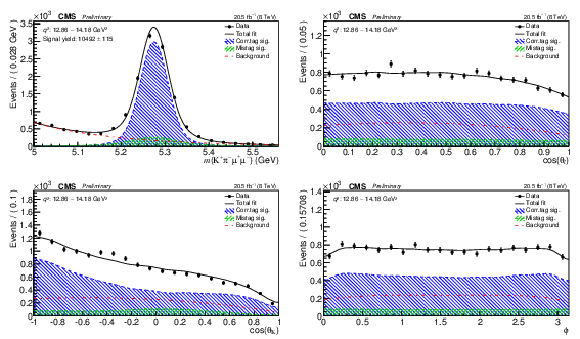
png pdf |
Additional Figure 13:
K+π−μ+μ− invariant mass and angular distributions of the control channel ψ′on data. Overlaid on each plot is the projection of the results for the total fit, as well as for the three components: correctly tagged signal, mistagged signal, and background. The vertical bars indicate the statistical uncertainties. |
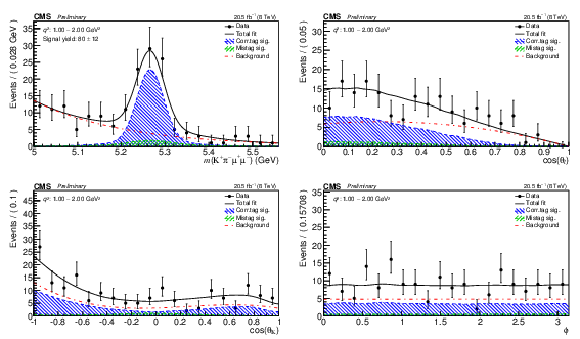
png pdf |
Additional Figure 14:
K+π−μ+μ− invariant mass and angular distributions for the first q2 bin 1.00 <q2< 2.00 GeV2. Overlaid on each plot is the projection of the results for the total fit, as well as for the three components: correctly tagged signal, mistagged signal, and background. The vertical bars indicate the statistical uncertainties. |
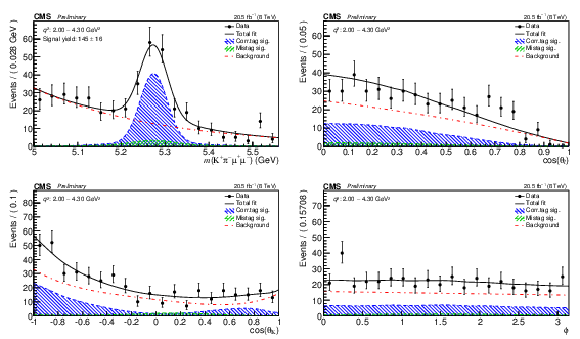
png pdf |
Additional Figure 15:
K+π−μ+μ− invariant mass and angular distributions for the second q2 bin 2.00 <q2< 4.30 GeV2. Overlaid on each plot is the projection of the results for the total fit, as well as for the three components: correctly tagged signal, mistagged signal, and background. The vertical bars indicate the statistical uncertainties. |
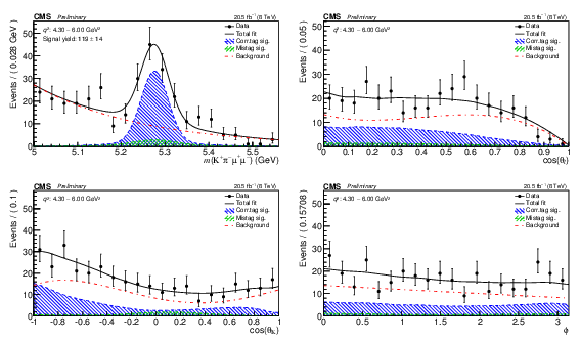
png pdf |
Additional Figure 16:
K+π−μ+μ− invariant mass and angular distributions for the third q2 bin 4.30<q2<6.00 GeV2. Overlaid on each plot is the projection of the results for the total fit, as well as for the three components: correctly tagged signal, mistagged signal, and background. The vertical bars indicate the statistical uncertainties. |
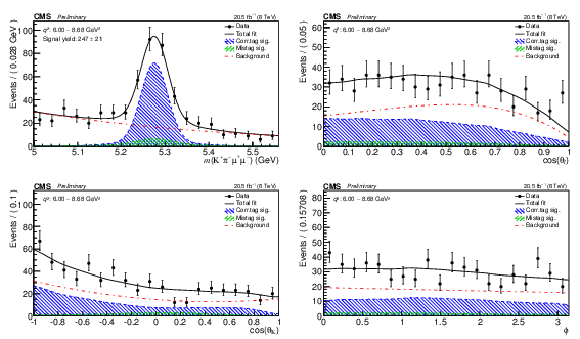
png pdf |
Additional Figure 17:
K+π−μ+μ− invariant mass and angular distributions for the fourth q2 bin 6.00<q2<8.68 GeV2. Overlaid on each plot is the projection of the results for the total fit, as well as for the three components: correctly tagged signal, mistagged signal, and background. The vertical bars indicate the statistical uncertainties. |
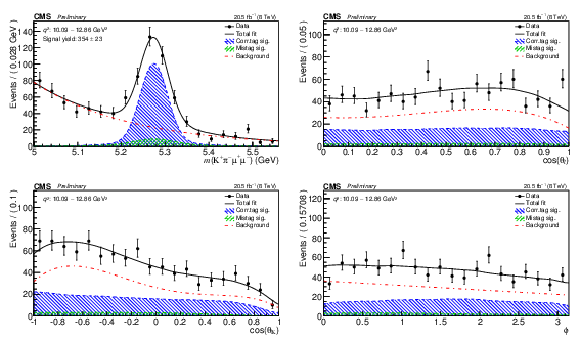
png pdf |
Additional Figure 18:
K+π−μ+μ− invariant mass and angular distributions for the fifth q2 bin 10.09 <q2< 12.86 GeV2. Overlaid on each plot is the projection of the results for the total fit, as well as for the three components: correctly tagged signal, mistagged signal, and background. The vertical bars indicate the statistical uncertainties. |
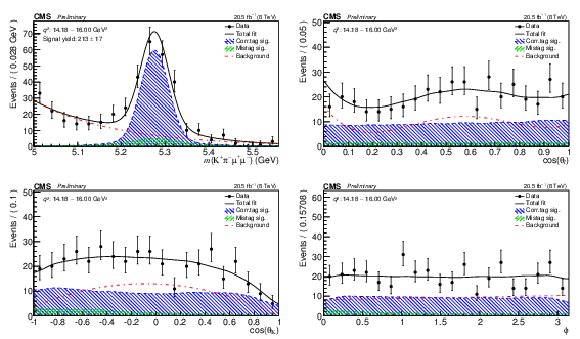
png pdf |
Additional Figure 19:
K+π−μ+μ− invariant mass and angular distributions for the sixth q2 bin 14.18 <q2< 16.00 GeV2. Overlaid on each plot is the projection of the results for the total fit, as well as for the three components: correctly tagged signal, mistagged signal, and background. The vertical bars indicate the statistical uncertainties. |
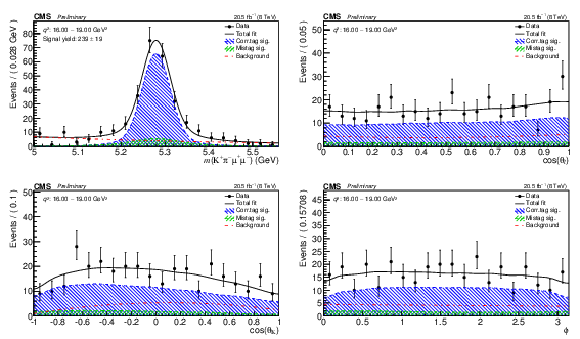
png pdf |
Additional Figure 20:
K+π−μ+μ− invariant mass and angular distributions for the seventh q2 bin 16.00 <q2< 19.00 GeV2. Overlaid on each plot is the projection of the results for the total fit, as well as for the three components: correctly tagged signal, mistagged signal, and background. The vertical bars indicate the statistical uncertainties. |
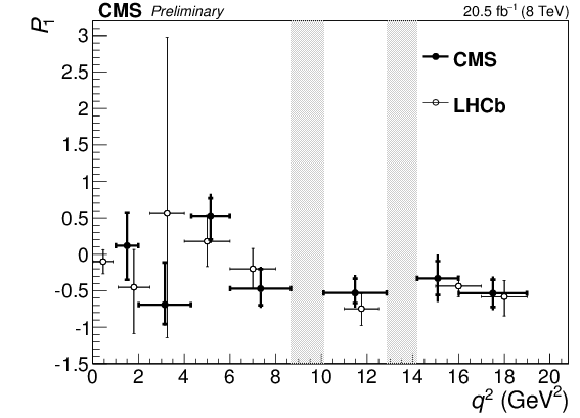
png pdf |
Additional Figure 21:
Measured values of P1 versus q2 for B0→K∗0μ+μ− from CMS, compared with LHCb [1] results. The statistical uncertainty is shown by the inner vertical bars, while the outer vertical bars give the total uncertainty. The horizontal bars show the bin widths. The vertical shaded regions correspond to the J/ψ and ψ′ resonances. |
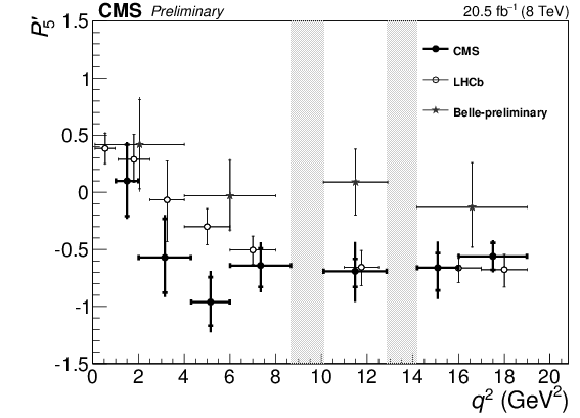
png pdf |
Additional Figure 22:
Measured values of P′5 versus q2 for B0→K∗0μ+μ− from CMS, compared with LHCb [1] and Belle [2] results. The statistical uncertainty is shown by the inner vertical bars, while the outer vertical bars give the total uncertainty. The horizontal bars show the bin widths. The vertical shaded regions correspond to the J/ψ and ψ′ resonances. |
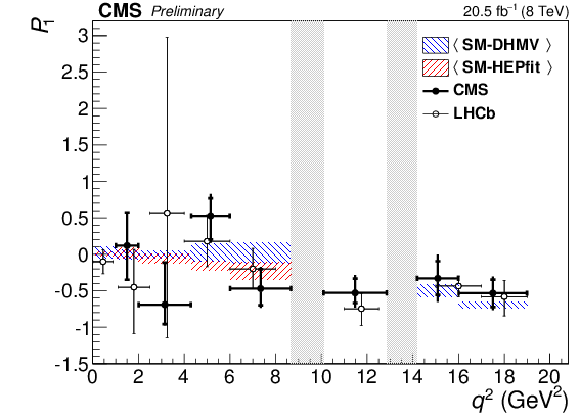
png pdf |
Additional Figure 23:
Measured values of P1 versus q2 for B0→K∗0μ+μ− from CMS, compared with LHCb [1] results. The statistical uncertainty is shown by the inner vertical bars, while the outer vertical bars give the total uncertainty. The horizontal bars show the bin widths. The vertical shaded regions correspond to the J/ψ and ψ′ resonances. The red and blue hatched regions show two SM predictions averaging over each q2 bin to provide a direct comparison to the data. The SM-DHMV result is derived from Refs. [3,4], while SM-HEPfit result from Refs. [5,6]. Reliable theoretical predictions are not available near the J/ψ and ψ′ resonances. |
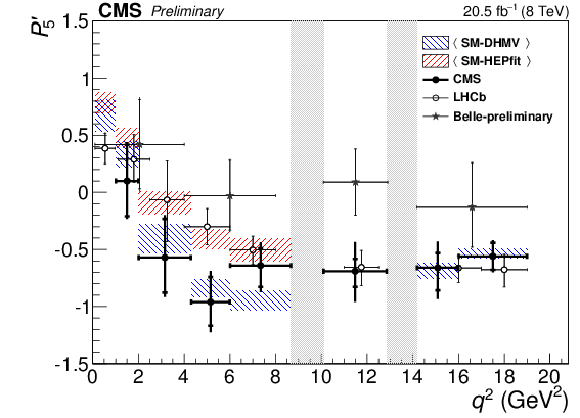
png pdf |
Additional Figure 24:
Measured values of P′5 versus q2 for B0→K∗0μ+μ− from CMS, compared with LHCb [1] and Belle [2] results. The statistical uncertainty is shown by the inner vertical bars, while the outer vertical bars give the total uncertainty. The horizontal bars show the bin widths. The vertical shaded regions correspond to the J/ψ and ψ′ resonances. The red and blue hatched regions show two SM predictions averaging over each q2 bin to provide a direct comparison to the data. The SM-DHMV result is derived from Refs. [3,4], while SM-HEPfit result from Refs. [5,6]. Reliable theoretical predictions are not available near the J/ψ and ψ′ resonances. |

png pdf |
Additional Figure 25:
Measured values of P′5 versus q2 for B0→K∗0μ+μ− from CMS, compared with LHCb [1] results. The statistical uncertainty is shown by the inner vertical bars, while the outer vertical bars give the total uncertainty. The horizontal bars show the bin widths. The vertical shaded regions correspond to the J/ψ and ψ′ resonances. The red and blue hatched regions show two SM predictions averaging over each q2 bin to provide a direct comparison to the data. The SM-DHMV result is derived from Refs. [3,4], while SM-HEPfit result from Refs. [5,6]. Reliable theoretical predictions are not available near the J/ψ and ψ′ resonances. |
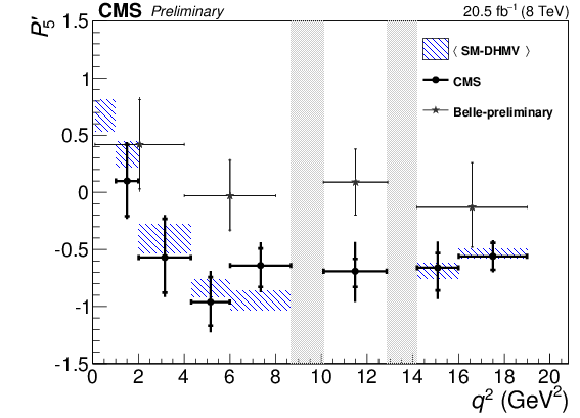
png pdf |
Additional Figure 26:
Measured values of P′5 versus q2 for B0→K∗0μ+μ− from CMS, compared with Belle [2] results. The statistical uncertainty is shown by the inner vertical bars, while the outer vertical bars give the total uncertainty. The horizontal bars show the bin widths. The vertical shaded regions correspond to the J/ψ and ψ′ resonances. The blue hatched region show the SM (SM-DHMV) predictions averaging over each q2 bin to provide a direct comparison to the data. The SM-DHMV prediction is derived from Refs. [3,4]. Reliable theoretical predictions are not available near the J/ψ and ψ′ resonances. |
| References | ||||
| 1 | W. Altmannshofer et al. | Symmetries and asymmetries of B→K∗μ+μ− decays in the Standard Model and beyond | JHEP 01 (2009) 019 | 0811.1214 |
| 2 | D. Melikhov, N. Nikitin, and S. Simula | Probing right-handed currents in B→K∗ℓ+ℓ− transitions | PLB 442 (1998) 381 | hep-ph/9807464 |
| 3 | A. Ali, P. Ball, L. T. Handoko, and G. Hiller | A comparative study of the decays B→(K,K∗)ℓ+ℓ− in the standard model and supersymmetric theories | PRD 61 (2000) 074024 | hep-ph/9910221 |
| 4 | Q.-S. Yan, C.-S. Huang, W. Liao, and S.-H. Zhu | Exclusive semileptonic rare decays B→(K,K∗)ℓ+ℓ− in supersymmetric theories | PRD 62 (2000) 094023 | hep-ph/0004262 |
| 5 | G. Buchalla, G. Hiller, and G. Isidori | Phenomenology of nonstandard Z couplings in exclusive semileptonic b→s transitions | PRD 63 (2000) 014015 | hep-ph/0006136 |
| 6 | T. Feldmann and J. Matias | Forward-backward and isospin asymmetry for B→K∗ℓ+ℓ− decay in the standard model and in supersymmetry | JHEP 01 (2003) 074 | hep-ph/0212158 |
| 7 | G. Hiller and F. Kruger | More model-independent analysis of b→s processes | PRD 69 (2004) 074020 | hep-ph/0310219 |
| 8 | F. Kruger and J. Matias | Probing new physics via the transverse amplitudes of B0→K∗0(→K−π+)ℓ+ℓ− at large recoil | PRD 71 (2005) 094009 | hep-ph/0502060 |
| 9 | W.-S. Hou, A. Hovhannisyan, and N. Mahajan | B→K∗ℓ+ℓ− forward-backward asymmetry and new physics | PRD 77 (2008) 014016 | hep-ph/0701046 |
| 10 | U. Egede et al. | New observables in the decay mode ¯Bd→¯K∗0ℓ+ℓ− | JHEP 11 (2008) 032 | 0807.2589 |
| 11 | T. Hurth, G. Isidori, J. F. Kamenik, and F. Mescia | Constraints on new physics in MFV models: A model-independent analysis of ΔF=1 processes | Nucl. Phys. B 808 (2009) 326 | 0807.5039 |
| 12 | A. K. Alok et al. | New-physics contributions to the forward-backward asymmetry in B→K∗μ+μ− | JHEP 02 (2010) 053 | 0912.1382 |
| 13 | A. K. Alok et al. | New physics in b→sμ+μ−: CP-conserving observables | JHEP 11 (2011) 121 | 1008.2367 |
| 14 | Q. Chang, X.-Q. Li, and Y.-D. Yang | B→K∗ℓ+ℓ−, Kℓ+ℓ− decays in a family non-universal Z′ model | JHEP 04 (2010) 052 | 1002.2758 |
| 15 | S. Descotes-Genon, D. Ghosh, J. Matias, and M. Ramon | Exploring new physics in the C7-C7′ plane | JHEP 06 (2011) 099 | 1104.3342 |
| 16 | J. Matias, F. Mescia, M. Ramon, and J. Virto | Complete anatomy of ¯Bd→¯K∗0(→Kπ)ℓ+ℓ− and its angular distribution | JHEP 04 (2012) 104 | 1202.4266 |
| 17 | S. Descotes-Genon, J. Matias, M. Ramon, and J. Virto | Implications from clean observables for the binned analysis of B→K∗μ+μ− at large recoil | JHEP 01 (2013) 048 | 1207.2753 |
| 18 | C. Bobeth, G. Hiller, and D. van Dyk | The benefits of ¯B→¯K∗ℓ+ℓ− decays at low recoil | JHEP 07 (2010) 098 | 1006.5013 |
| 19 | C. Bobeth, G. Hiller, D. van Dyk, and C. Wacker | The decay ¯B→¯Kℓ+ℓ− at low hadronic recoil and model-independent ΔB= 1 constraints | JHEP 01 (2012) 107 | 1111.2558 |
| 20 | C. Bobeth, G. Hiller, and D. van Dyk | General analysis of ¯B→¯K(∗)ℓ+ℓ− decays at low recoil | PRD 87 (2012) 034016 | 1212.2321 |
| 21 | A. Ali, G. Kramer, and G. Zhu | B→K∗ℓ+ℓ− decay in soft-collinear effective theory | EPJC 47 (2006) 625 | hep-ph/0601034 |
| 22 | W. Altmannshofer, P. Paradisi, and D. M. Straub | Model-independent constraints on new physics in b→s transitions | JHEP 04 (2012) 008 | 1111.1257 |
| 23 | S. Jager and J. Martin Camalich | On B→Vℓℓ at small dilepton invariant mass, power corrections, and new physics | JHEP 05 (2013) 043 | 1212.2263 |
| 24 | S. Descotes-Genon, T. Hurth, J. Matias, and J. Virto | Optimizing the basis of B→K∗ℓ+ℓ− observables in the full kinematic range | JHEP 05 (2013) 137 | 1303.5794 |
| 25 | BaBar Collaboration | Angular distributions in the decay B→K∗ℓ+ℓ− | PRD 79 (2009) 031102 | 0804.4412 |
| 26 | Belle Collaboration | Measurement of the differential branching fraction and forward-backward asymmetry for B→K(∗)ℓ+ℓ− | PRL 103 (2009) 171801 | 0904.0770 |
| 27 | CDF Collaboration | Measurements of the angular distributions in the decays B→K(∗)μ+μ− at CDF | PRL 108 (2012) 081807 | 1108.0695 |
| 28 | LHCb Collaboration | Differential branching fraction and angular analysis of the decay B0→K∗0μ+μ− | JHEP 08 (2013) 131 | 1304.6325 |
| 29 | CMS Collaboration | Angular analysis of the decay B0→K∗0μ+μ− from pp collisions at √s= 8 TeV | PLB 753 (2016) 424 | CMS-BPH-13-010 1507.08126 |
| 30 | LHCb Collaboration | Angular analysis of the B0→K∗μ+μ− decay using 3 fb−1 of integrated luminosity | JHEP 02 (2016) 104 | 1512.04442 |
| 31 | S. Descotes-Genon, J. Matias, and J. Virto | Global analysis of b→sℓℓ anomalies | JHEP 06 (2016) 092 | 1510.04239 |
| 32 | Belle Collaboration | Lepton-Flavor-Dependent angular analysis of B→K∗ℓ+ℓ− | Submitted to PRL | 1612.05014 |
| 33 | CMS Collaboration | CMS luminosity based on pixel cluster counting - Summer 2013 update | CMS-PAS-LUM-13-001 | CMS-PAS-LUM-13-001 |
| 34 | CMS Collaboration | The CMS experiment at the CERN LHC | JINST 3 (2008) S08004 | CMS-00-001 |
| 35 | CMS Collaboration | Description and performance of track and primary-vertex reconstruction with the CMS tracker | JINST 9 (2014) P10009 | CMS-TRK-11-001 1405.6569 |
| 36 | CMS Collaboration | Performance of CMS muon reconstruction in pp collision events at √s= 7 TeV | JINST 7 (2012) P10002 | CMS-MUO-10-004 1206.4071 |
| 37 | Particle Data Group, C. Patrignani et al. | The Review of Particle Physics | CPC 40 (2016) 100001 | |
| 38 | T. Sjostrand, S. Mrenna, and P. Skands | PYTHIA 6.4 physics and manual | JHEP 05 (2006) 026 | hep-ph/0603175 |
| 39 | D. J. Lange | The EvtGen particle decay simulation package | NIMA 462 (2001) 152 | |
| 40 | GEANT4 Collaboration | GEANT4---a simulation toolkit | NIMA 506 (2003) 250 | |
| 41 | D. Be\vcirevi\'c and A. Tayduganov | Impact of B→K∗0ℓ+ℓ− on the New Physics search in B→K∗ℓ+ℓ− decay | Nucl. Phys. B 868 (2013) 368 | 1207.4004 |
| 42 | J. Matias | On the S-wave pollution of B→K∗ℓ+ℓ− observables | PRD 86 (2012) 094024 | 1209.1525 |
| 43 | T. Blake, U. Egede, and A. Shires | The effect of S-wave interference on the B0→K∗0ℓ+ℓ− angular observables | JHEP 03 (2013) 027 | 1210.5279 |
| 44 | D. W. Scott | Wiley series in probability and mathematical statistics: Applied probability and statistics section. Wiley-Interscience, New York, Chichester, Brisbane, 1992 | ||
| 45 | K. S. Cranmer | Kernel estimation in high-energy physics | CPC 136 (2001) 198 | hep-ex/0011057 |
| 46 | F. James and M. Roos | Minuit---a system for function minimization and analysis of the parameter errors and correlations | CPC 10 (1975) 343 | |
| 47 | G. J. Feldman and R. D. Cousins | Unified approach to the classical statistical analysis of small signals | PRD 57 (1998) 3873 | physics/9711021 |
| 48 | M. Ciuchini et al. | B→K∗ℓ+ℓ− decays at large recoil in the Standard Model: a theoretical reappraisal | JHEP 06 (2016) 116 | 1512.07157 |
| 49 | M. Ciuchini et al. | B→K∗ℓ+ℓ− in the Standard Model: elaborations and interpretations | 1611.04338 | |
| 50 | P. Ball and R. Zwicky | Bd,s→ρ,ω,K∗,ϕ decay form factors from light-cone sum rules reexamined | PRD 71 (2005) 014029 | hep-ph/0412079 |
| 51 | A. Bharucha, D. M. Straub, and R. Zwicky | B→Vℓ+ℓ− in the Standard Model from light-cone sum rules | JHEP 08 (2016) 098 | 1503.05534 |
| 52 | R. R. Horgan, Z. Liu, S. Meinel, and M. Wingate | Lattice QCD calculation of form factors describing the rare decays B→K∗ℓ+ℓ− and Bs→ϕℓ+ℓ− | PRD 89 (2014) 094501 | 1310.3722 |
| 53 | A. Khodjamirian, T. Mannel, A. A. Pivovarov, and Y.-M. Wang | Charm-loop effect in B→K(∗)ℓ+ℓ− and B→K∗γ | JHEP 09 (2010) 089 | 1006.4945 |

|
Compact Muon Solenoid LHC, CERN |

|

|

|

|

|

|